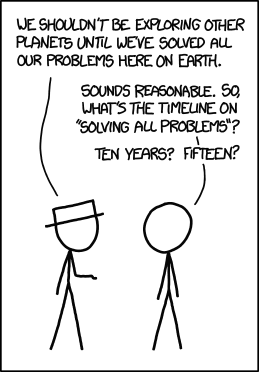There will be a partial eclipse of the moon on Friday October 18. The moon will pass through the edge of the Earth’s shadow, ending up partially in the shadow of the Earth.
The moon passes through the edge of the Earth’s shadow at dusk on Friday October 18, as seen from eastern North America. Credit: Starry Night Software
If you look closely at any shadow cast by the sun, say the one cast by your hand on a piece of paper, you will notice that the edge of the shadow isn’t sharp. That’s because the sun is not a point source of light. It is a disk, so the shadows it casts are slightly fuzzy. The solid dark part of the shadow is called the “umbra,” Latin for “shade.” The fuzziness is called the “penumbra,” Latin for “almost shade.”
When a shadow is cast by a nearby object, the penumbra is very slight. When the shadow is as far away as the moon is from the Earth, the penumbra is quite wide.
The graphic shows the situation at maximum eclipse at 7:50 p.m. EDT on Friday night, October 18. The inner circle is the umbra, the outer circle the penumbra. The moon makes it part way into the penumbra, but misses the umbra completely, hence this is a “partial penumbral eclipse.”
For observers in Africa, Europe, and western Asia, the eclipse will occur in the middle of the night when the moon is high overhead. The partial shading will be visible as a slight reddish dimming of the normally bright full moon.
For observers in North America and South America, maximum eclipse will be around the time of moonrise, which is also the time of sunset. This will make the eclipse difficult to see, because we will be looking for a slight dimming of a moon which is already dimmed by passing through a great deal of the Earth’s atmosphere.
The farther east and north you are located, the better your chances of seeing this eclipse. For example, in New York City, the moon will rise at 5:59 p.m. EDT, and will be at an altitude of 20 degrees at maximum eclipse. In Chicago, moonrise is at 5:54 p.m. CDT and the moon’s altitude only 9 degrees at maximum eclipse. In Los Angeles, moonrise is at 6:09 p.m. PDT, more than an hour after maximum eclipse, so the chances of seeing the eclipse are zero.
For observers in North America, the effects of the moon’s shadow will be most pronounced on the lower right corner of the moon. The shadow will probably be more pronounced in photographs than with the naked eye, so this is a good opportunity to get out your telephoto lens and photograph the rising moon. Remember that maximum eclipse will be at 7:50 p.m. EDT and 6:50 p.m. CDT.

